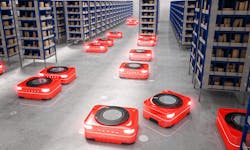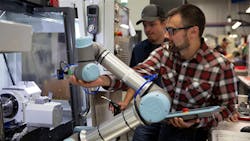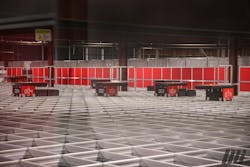Emergent Robotics: Pioneering Solutions in Modern Industrial Automation
Continually pushing the boundaries of industrial automation, robotics delivers unparalleled efficiencies and solutions that were once deemed the stuff of science fiction. Industries across sectors are racing to leverage robotics to transform and optimize their operations. Exciting solutions reshaping the industrial landscape include collaborative, mobile autonomous, swarm and vision-guided robots.
Collaborative Robots
Large-scale robots are often isolated from workers due to safety concerns. They are sometimes massive, exceptionally heavy, and usually placed behind safety glass or industrial framing cages. Unlike these conventional industrial robots, collaborative robots (cobots) are designed to work and share space with humans. They are built with safety features such as force and torque sensors, so the cobot would instantly stop or slow down its operation if it comes into unexpected contact with a human worker.
Cobots are designed specifically to enhance human capabilities rather than replace them. They are programmable, adaptable and user-friendly. While traditional robots require specialized knowledge to program and operate, workers don’t need a robotics background to reprogram cobots when required.
Industrial applications for cobots are vast. Cobots are used in many industrial processes, including assembly line operations, machine tending, pick-and-place, quality control and collaborative welding.
While cobots enhance production and efficiency, they also benefit the overall worker experience. Leaving boring, repetitive tasks to cobots allows workers to focus on more substantial, complex and fulfilling jobs. Cobots also reduce the physical strain humans can experience with repeated movements.
The introduction of cobots in the workspace was a paradigm shift in how we perceive robotics. Robots are not replacing human workers; if anything, the cobot and human worker can both leverage their unique strengths. The technological advances of cobots and robotics are playing an even bigger role in shaping the future of manufacturing.
Mobile Autonomous Robots
Industrial floors are hubs of activity. Precision, timing and efficiency are paramount. Mobile autonomous robots add a new layer of adaptability and intelligence to manufacturing operations. They are used in industrial applications such as material handling and transportation, inventory management, safety and security, collaborative picking, facility cleaning and more.
Unlike traditional stationary robots, mobile autonomous robots are not tethered to a specific location. They have sensors, cameras and advanced navigation algorithms that enable them to move freely across the factory floor without human intervention. Infrared sensors and depth cameras map these robots’ surroundings, so they avoid obstacles and reach their destinations safely.
Mobile autonomous robots are highly adaptable. Manufacturing lines and warehouses often change layouts, but these robot types require little reprogramming and can adjust quickly. Also, industries can scale their operations by adding more mobile autonomous robots rapidly and easily.
Collision avoidance systems, emergency stop functions and real-time monitoring ensure that human workers and these robots can coexist harmoniously.
The real-time data, enhanced safety and adaptability of these mobile autonomous robots signal an industrial automation transformation. As their capabilities expand and technology advances, mobile autonomous robots may play an even more central role in manufacturing efficiency and production.
Swarm Robots
Swarm robotics is turning traditional robotics on its head. Once, we had a single, powerful machine. But now, swarm robotics focuses on strength in numbers. Mimicking the natural behavior of ants, bees or birds, swarm robots work with coordinated action.
Each swarm robot operates based on local information and simple rules. Instead of a single control source, swarm robotics works on the principle of decentralized control. The collective behavior comes from the individual robots interacting with each other and the environment.
Because swarm robotics offers scalability, flexibility and robustness, they are highly desirable in large warehouse footprints. Without changing or modifying the system, swarm robots can easily be scaled up or down by adding or removing a robot. This flexibility allows for fluctuation in demand.
If a robot malfunctions, operations can carry on because of the decentralized nature of the control system. If a robot shuts down, the swarm continues its tasks.
Distributed assembly, warehouse management, surveillance and inspection, and cleaning and maintenance are all perfect uses of swarm robots.
Swarm robots are a significant departure from traditional approaches to industrial automation. Collective action and decentralization mark a leap in robotic advancement. As innovation continues, we can expect swarm robotics to integrate more into industrial applications.
Vision-Guided Robots
Vision-guided robotics (VGR) is a game-changer in the industrial arena. These robots can “see” and “understand” their surroundings. VGR equips robots with vision inspection sensors and algorithms to process and interpret images. Manufacturers are embracing this robotic technology and the possibilities are endless.
Sophisticated image-processing software and high-resolution cameras work together with VGR. The robot uses cameras to gather visual data from its surroundings and process it in real-time. Then, the robot can make decisions or change its movements.
VGR’s benefits for industrial automation include decreased fixturing, improved flexibility and greater precision. Traditional robots are often in highly structured environments, whereas VGR allows for adaptation to variations. They can work with a broader range of products and switch tasks without manual assistance.
By seeing and processing, VGRs achieve high levels of accuracy and excel in tasks like assembly, pick-and-place operations and material handling. VGR can also identify parts presented in random orientations. Thus, custom or static fixtures in more traditional robotics applications are unnecessary, saving the manufacturer time and money in the long run.
Integrated with artificial intelligence (AI) and machine learning capabilities, VGR can provide facilities with consistent quality control inspection. VGR, combined with AI algorithms, can identify and recognize objects and detect defects in products ranging from medical syringes to automotive engines. As this integrated system processes more and more data, its accuracy and efficiency improve.
Integrated into Infrastructure
Today’s industrial work is reimagining human and robot worker collaboration. Cobots enable smooth integrations and symbiotic work environments where humans and robots complement one another’s advantages. Mobile autonomous robots are redefining the logistics warehouse with their independence and agility. Swarm robotics demonstrates the strength of the collective and that the whole is more impressive than the sum of its parts. VGR, especially with its AI integration, has reformed what robots are capable of: perceiving, understanding and interacting with surroundings like never before.
We will see robotics increasingly used across all manufacturing industries and business sectors. Robotics is no longer a luxury but vital in the industrial automation space. This leap in technology and innovation is exciting and essential to industrial growth.
Tara Van Geons is the business group marketing manager for Motion. She spent the last decade working in automation and has been a contributing author for several industry publications. For more information, visit ai.motion.com.



